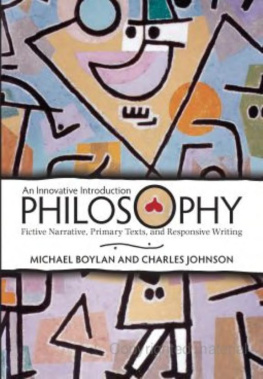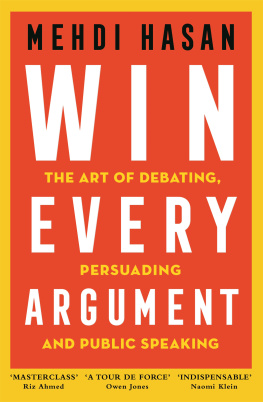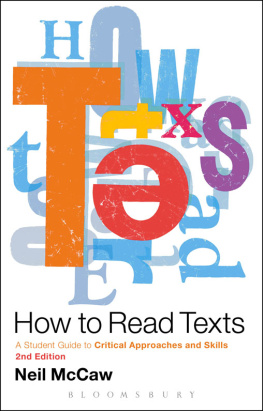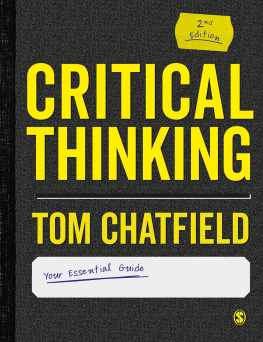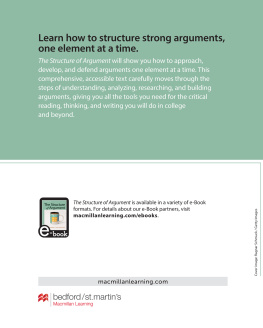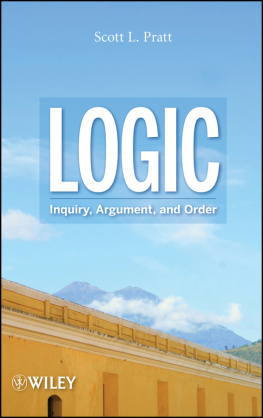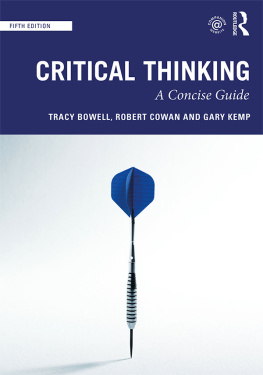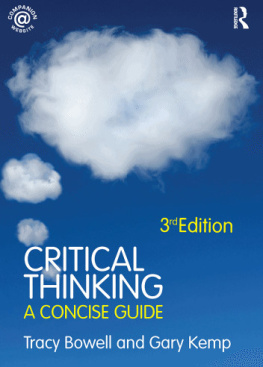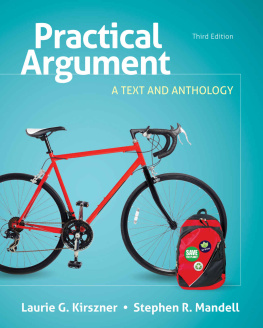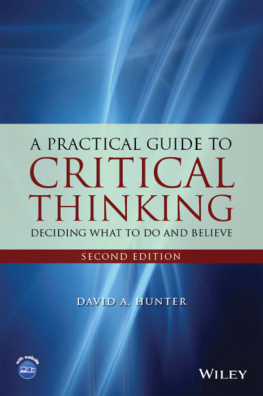First published 2010 by Westview Press
Published 2018 by Routledge
711 Third Avenue, New York, NY 10017, USA
2 Park Square, Milton Park, Abingdon, Oxon OX14 4RN
Routledge is an imprint of the Taylor & Francis Group, an informa business
Copyright 2010 by Michael Boylan
All rights reserved. No part of this book may be reprinted or reproduced or utilised in any form or by any electronic, mechanical, or other means, now known or hereafter invented, including photocopying and recording, or in any information storage or retrieval system, without permission in writing from the publishers.
Notice:
Product or corporate names may be trademarks or registered trademarks, and are used only for identification and explanation without intent to infringe.
Designed by Trish Wilkinson
Set in 11.5-point Janson
Library of Congress Cataloging-in-Publication Data
Boylan, Michael, 1952
Critical inquiry : the process of argument / Michael Boylan.
p. cm.
Rev. ed. of: The process of argument. 1988.
Includes bibliographical references and index.
ISBN 978-0-8133-4452-2 (pbk. : alk. paper) 1. English languageRhetoric. 2. Persuasion (Rhetoric) 3. Critical thinking. 4. Language and logic. 5. Reasoning. I. Boylan, Michael, 1952 Process of argument. II. Title.
PE1431.B67 2010
808.042dc22
2009015178
ISBN 13: 978-0-8133-4452-2 (pbk)
T his book is in one way the second edition of The Process of Argument (Prentice Hall, 1988). However, it is more than just a second edition, but an entirely revised project that is supported by a new publisher, Westview. The first book was designed to be an informal logic text with the intent that it would be used in classes centered around critical thinkingthen a nascent field. In fact, the American Association for Higher Education had a session on critical thinking shortly after publication and featured The Process of Argument among a few others as examples of how this new field might develop.
After twenty years of continual classroom adoptions, it seems to me that there is good reason to update and reorient the book. The new emphasis is upon how to read and respond critically to argumentative texts. In this way the text has transformed into one that emphasizes critical inquiry through the three rs of reading, reconstructing, and responding to argumentative texts. This is an important skill that is necessary in many courses in the curriculum. For example, in philosophy all the texts presented are argumentative so that this book can instruct the student in achieving the requisite skills needed to read and analyze texts. But these skills are not confined to philosophy. In literature classes, it is commonplace to teach two sorts of essays: (a) the expository (or research) essay and (b) the argumentative essay. This book would be useful for courses in the latter domain. It might also be useful for upper-level literature courses that want to incorporate critical theory. This is because the bounds of critical theory are the logically acceptable categories of deductive and inductive reasoning (both represented here). Students of composition classes as well as upper-level theory classes could profit from exposure to a succinct handbook on argumentincluding rules on understanding, reconstructing, and responding to the same.
Other classes in the curriculum such as politics, economics, and business also require facility in confronting argument successfully. The crossover between disciplines respecting argument is very high. For fourteen years I have led a faculty seminar on ethics and logical argument to professors across the disciplines. This book reflects my experiences. I have also used this method of teaching argument when I was first an English literature teacher in 1976 and later, a philosophy teacher from 1979 onward. So this book also represents thirty-two years of classroom experience.
The presentation is divided into three parts: reading the text, reconstructing the text, and responding to the text (the three rs). In reading the text students are presented with critical tools so that they might not simply accept the text as given. Instead, students are encouraged to go through some self-examination that will enable them to understand their own critical standpoint. This is essential in order that they might be able to ascertain what the speaker is saying and subsequently whether the presentation is correct. I should point out that in the first two sections of the book there is a presentation of how to confront media claims as well as those from the traditional written word.
In reconstructing the text the student is presented with a self-contained system of informal logic. The rules are few and focused on the practical outcomes of enabling the student to confront an argumentative text and to reconstruct the important arguments contained within. These reconstructed arguments are formally presented according to the rules of the system. By making students go through this process, they are forced to give an interpretation of the logical argument contained within. This constitutes another level of understanding that will facilitate better critical inquiry.
Finally, there is the level of responding to the text. In this case the student is enjoined to write a clear pro or con essay. The point of making this clear decision is to promote straightforward argumentative thinking. This is always best achieved when students must make difficult choices. Many students want to be fence-sitters and avoid taking a stance. But this mars their ability to create clear arguments.
This text thus sees itself as promoting the three rs: reading, reconstructing, and responding to the text. If this book can better facilitate student outcomes in creating argumentative essays, then it will be a success. I welcome teacher feedback for the next edition of this book, which can be sent to Boylan.Critical.Inquiry@gmail.com. Key features of this book include:
Guidance on how to read a text through selfanalysis and social criticism
Tools on how to reconstruct logical argument in a structured manner
A step-by-step procedure to move from reading to a reflective packet that allows the student to be in the position to write an argumentative essay
Guidelines on how to structure an argumentative, pro or con essay
It is the intention of this book to assist the student in this process from the point of opening the book to the time when he or she turns in their essay.
Acknowledgments
In addition to those noted in the first edition, I would like to thank Karl Yambert, my editor, who has helped me realize my vision for the project, and all the rest of the Westview team. My thanks also to the professors who took my faculty ethics seminars where I employed many of the techniques found in this book. Their feedback helped me clarify my thoughts and see what might work in a variety of disciplines. In addition, I need to acknowledge Barry Erdeljon, who gave me some good advice on advertising for . Finally, I would like to thank those who have been my students over the past thirty-two years. There is no better way to find out what works and what doesnt than through direct interaction with students.


